Python Libraries How to Know You Have
PYTHON
5 Python Libraries That You Don't Know Almost, But Should
Find 5 Python libraries that you lot should start using right now

One of the all-time things about using Python is its infinity of open-source libraries. At that place is a library for basically annihilation. If you have read some of my previous blogs, you may have noticed that I'1000 a big fan of depression-code libraries. That's not because I'm lazy to type lawmaking only because I adopt investing my fourth dimension working on a project with what actually matters. If a library tin solve a problem, why not save your precious time and give it a try? Today, I volition introduce you to 5 libraries that you lot probably have never heard about only you should add together to your pipeline. Allow's become started!
PyForest
When you lot offset typing your lawmaking for a project, what is your first pace? Y'all probably import the libraries y'all will need, correct? The problem is that you never know how many libraries you will demand until y'all need it and get an mistake. That's why PyForest is one of the handiest libraries that I know. PyForest tin can import the twoscore most popular libraries to your notebook with 1 line of code. Forget well-nigh trying to recollect how to phone call each library. PyForest can practise that for yous. I have written a whole web log nigh it, but in brusque, you install it, telephone call it, and use it! All that in a few seconds. How most the aliases? Don't worry about it. They volition exist imported with the aliases that we are familiar with.
How to use information technology
Just type pip install pyforest and you are skillful to get. To import it to your notebook, blazon from pyforest import * and y'all can beginning using your libraries. To bank check which libraries were imported, type lazy_imports().
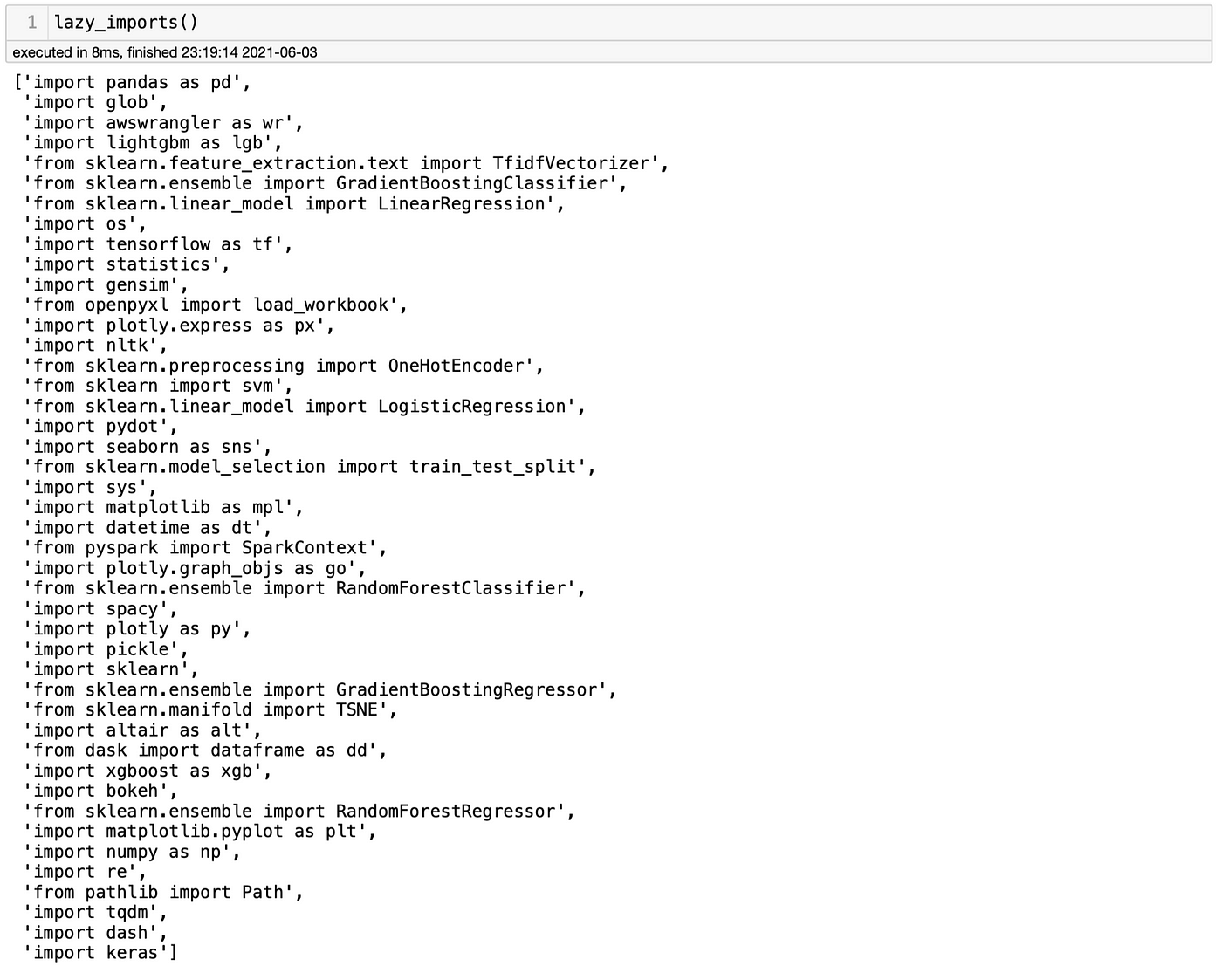
All the libraries above are expert to use. Technically, they will only be imported if you employ them. Otherwise, they will non. You lot tin meet libraries such as Pandas, Matplotlib, Seaborn, Tensorflow, Sklearn, NLTK, XGBoost, Plotly, Keras, Numpy, and many others.
I generally use PyForest for my personal projects or projects that will not be reviewed by other people. If your code will be reviewed by other people, PyForest is not recommended for non making articulate that these libraries are being imported.
Emot
Emot is a squeamish-to-take library that has the potential to improve past a lot your adjacent NLP project. It transforms emojis and emoticons into descriptive information. For instance, imagine that someone posted "I ❤️ Python" on Twitter. The person didn't say the give-and-take beloved. Instead, they used an emoji. If yous employ this tweet in an NLP project, you will have to remove the emoji and lose a big slice of information. That's when Emot comes in. It transforms emojis and emoticons into words. For those who are non familiar, emoticons are ways to express sentiments using characters. For case, :) for a smiley confront or :( for a sad confront.
How to use
To install it, you lot can type pip install emot, and you are good to go. And then yous volition demand to import information technology into your notebook by typing import emot. You will need to determine if you want to figure out the meaning of emojis or emoticons. For emojis, the code is emot.emoji(your_text). Allow's check it out with an example:

You lot tin see above that I added the sentence I ❤️ Python 🙂 and used Emot to figure it out. It returned a dictionary with the values, the description, and the location. Like whatsoever dictionary, you can slice it and focus on the data that you demand. If I type ans['mean'], it will render but the emoji description.

Geemap
I'chiliad including Geemap to this listing, but to be honest, it deserves an entire blog about it. In short, Geemap is a Python library that allows interactive mapping with Google World Engine. You are probably familiar with Google Globe and all its ability, so why not use information technology for your adjacent project? I'm planning to create a project to explore all its functionalities in the next few weeks. In the concurrently, here is how you tin can install and start using information technology.
How to employ it
You tin install it by typing pip install geemap in your Concluding. To import it to your notebook, you can type import geemap. For demonstration purposes, I volition create a folium-based interactive map using the following code:
import geemap.eefolium every bit geemap
Map = geemap.Map(center=[40,-100], zoom=4)
Map 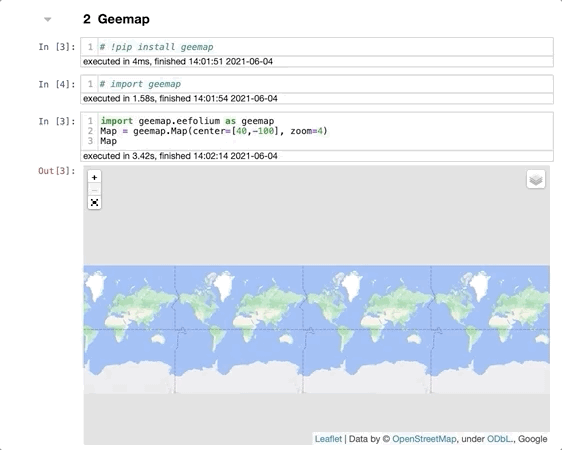
Every bit I mentioned, I haven't explored it as much as it deserves, merely they have a consummate GitHub README talking more than about how information technology works and what information technology can practise.
Dabl
I learned about Dabl yesterday, and after doing some inquiry, I found out that it deserves its own blog, simply let'southward cover the basics. Dabl aims to brand machine learning modeling more accessible for beginners. For this reason, information technology uses low-code solutions for machine learning projects. Dabl simplifies data cleaning, creating visualizations, building baseline models, and explaining models. Let's speedily review some of its functionalities.
How to utilize
First, to install it, you can simply type pip install dabl in your terminal. Then, you tin import Dabl to your notebook by typing import dabl. You are expert to go from hither. You tin utilise dabl.make clean(data) to get information most features, such as if there is any useless features. It also shows continuous, categorical, and high-cardinality features.
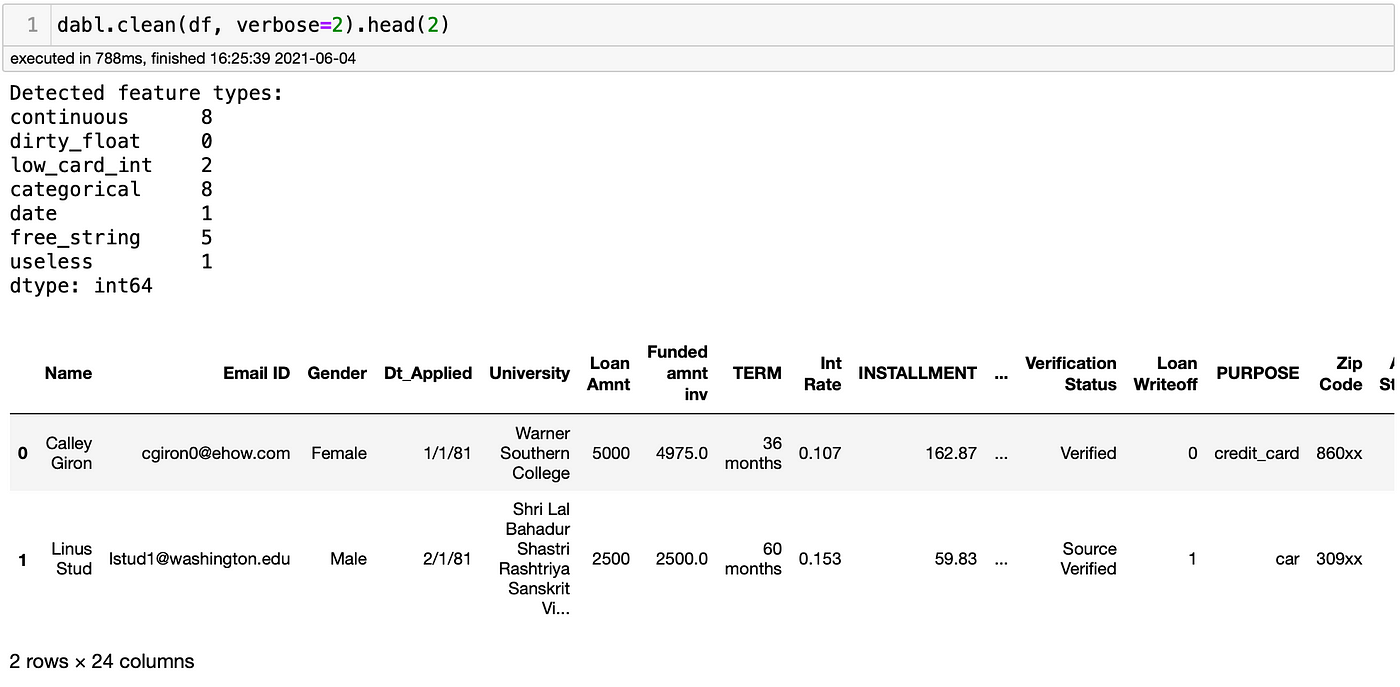
You can use dabl.plot(data) to generate visualizations about a specific feature:
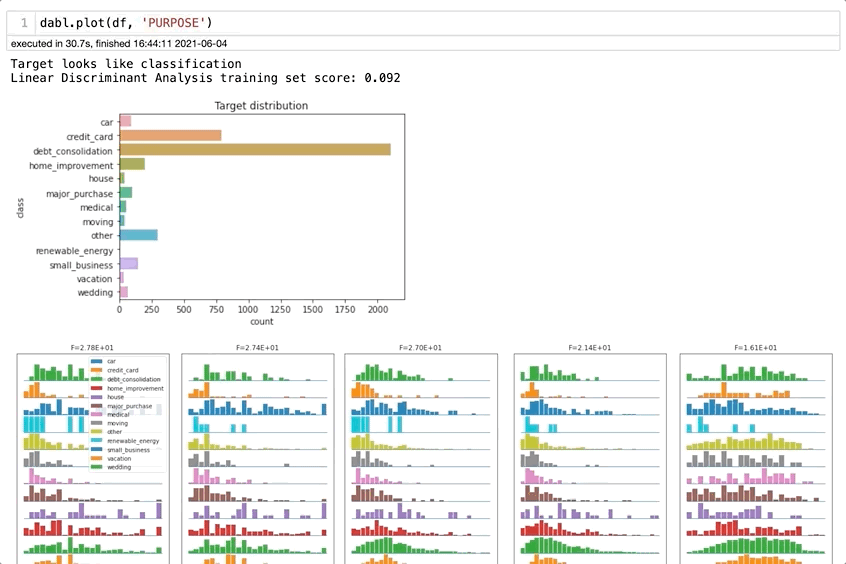
And finally, you can create multiple models with one line of lawmaking using dabl.AnyClassifier or dabl.Simplefier() just like you lot would do using Scikit-Learn. However, in this step, you lot will have to take some of the steps you lot would usually take, such as creating grooming and testing dataset, calling, plumbing equipment and predicting the model. Then, you can apply Scikit-Learn to evaluate the model.
# Setting 10 and y variables
10, y = load_digits(return_X_y=True) # Splitting the dataset into train and test sets X_train, X_test, y_train, y_test = train_test_split(X, y, random_state=1) # Calling the model
sc = dabl.SimpleClassifier().fit(X_train, y_train) # Evaluating accuracy score
print("Accuracy score", sc.score(X_test, y_test))
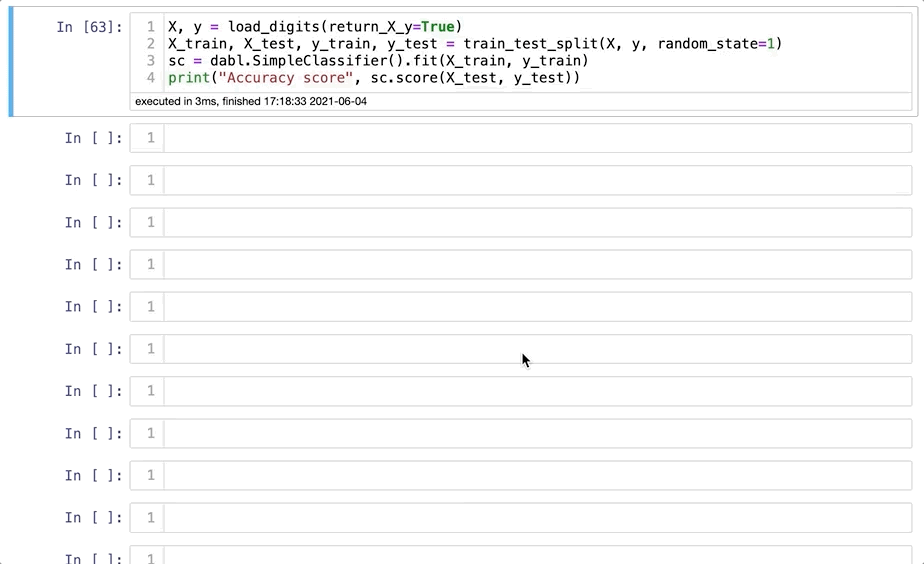
As we tin can run across, Dabl iterated through multiple models, including Dummy Classifier, GaussianNB, Decision Trees with dissimilar depths, and Logistic Regression. At the end, it shows the best model. All these models in about x seconds. Cool, right? I decided to examination the final model using Scikit-Acquire to brand sure that this result was trustworthy. Hither is the result:

I got 0.968 accuracy using the conventional fashion to predict and 0.971 with Dabl. That's shut enough for me! Note that I didn't have to import the Logistic Regression model from the Scikit-Acquire library because information technology was already imported with PyForest. I need to confess that I adopt LazyPredict, only Dabl is worth trying. There is much more to prove about Dabl, and I will work on a weblog exclusively for it with more details. Stay tuned!
SweetViz
Sweetviz is a low-lawmaking Python library that generates cute visualizations to kickstart your exploratory data analysis with two lines of code. The output is an interactive HTML file. Like other libraries that I mentioned today, SweetViz deserves its own blog, and I will publish ane soon. For now, permit's get a high overview of it.
How to use it
my_report = sv.clarify(dataframe)
my_report.show_html() 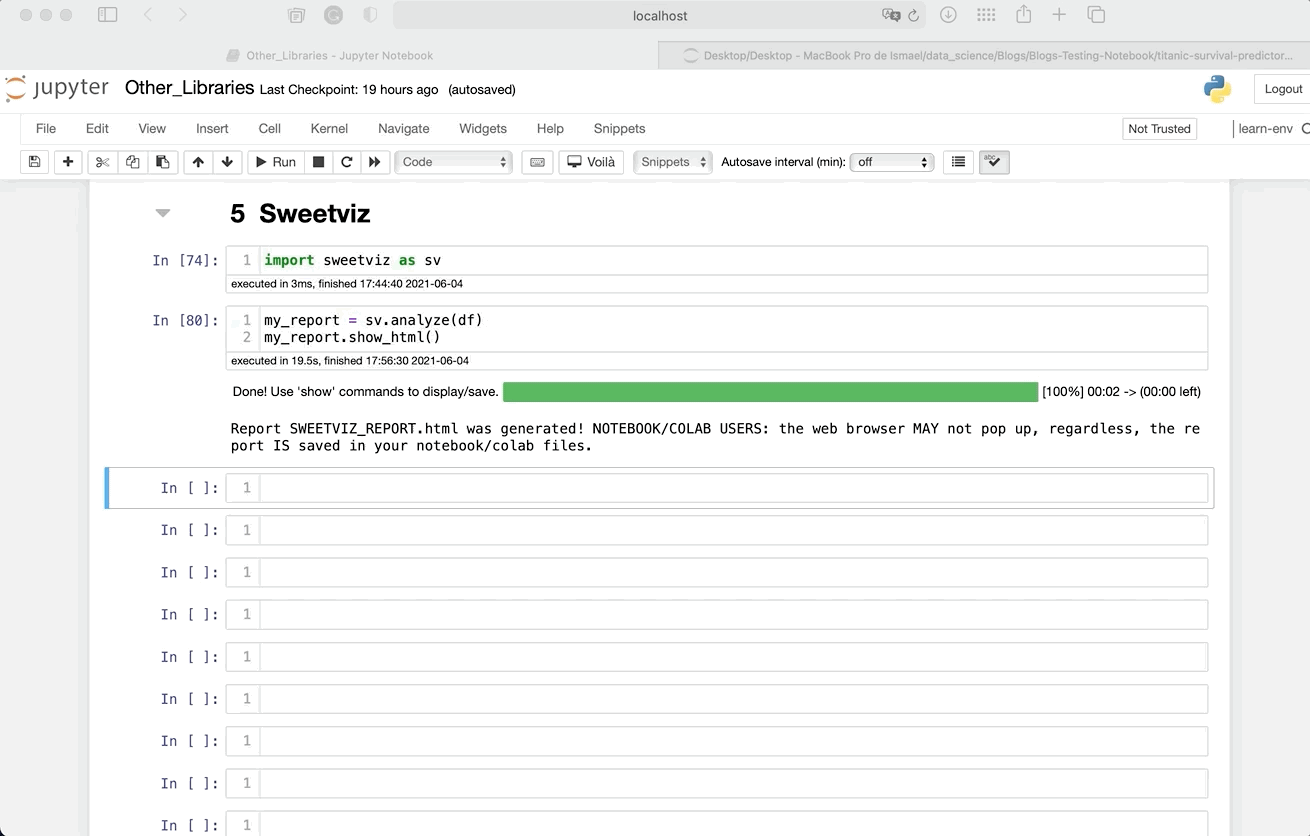
Did you see that? Sweetviz was able to create an EDA HTML file with information nigh the entire dataset and break it down and so that you tin analyze each feature individually. You can get the numerical and chiselled association to other features, largest, smallest, and most frequent values. The visualization also changes depending on the information type. Y'all can do then much more with Sweetviz, merely I will go on it for another blog. In the meantime, I highly recommend you trying it out.
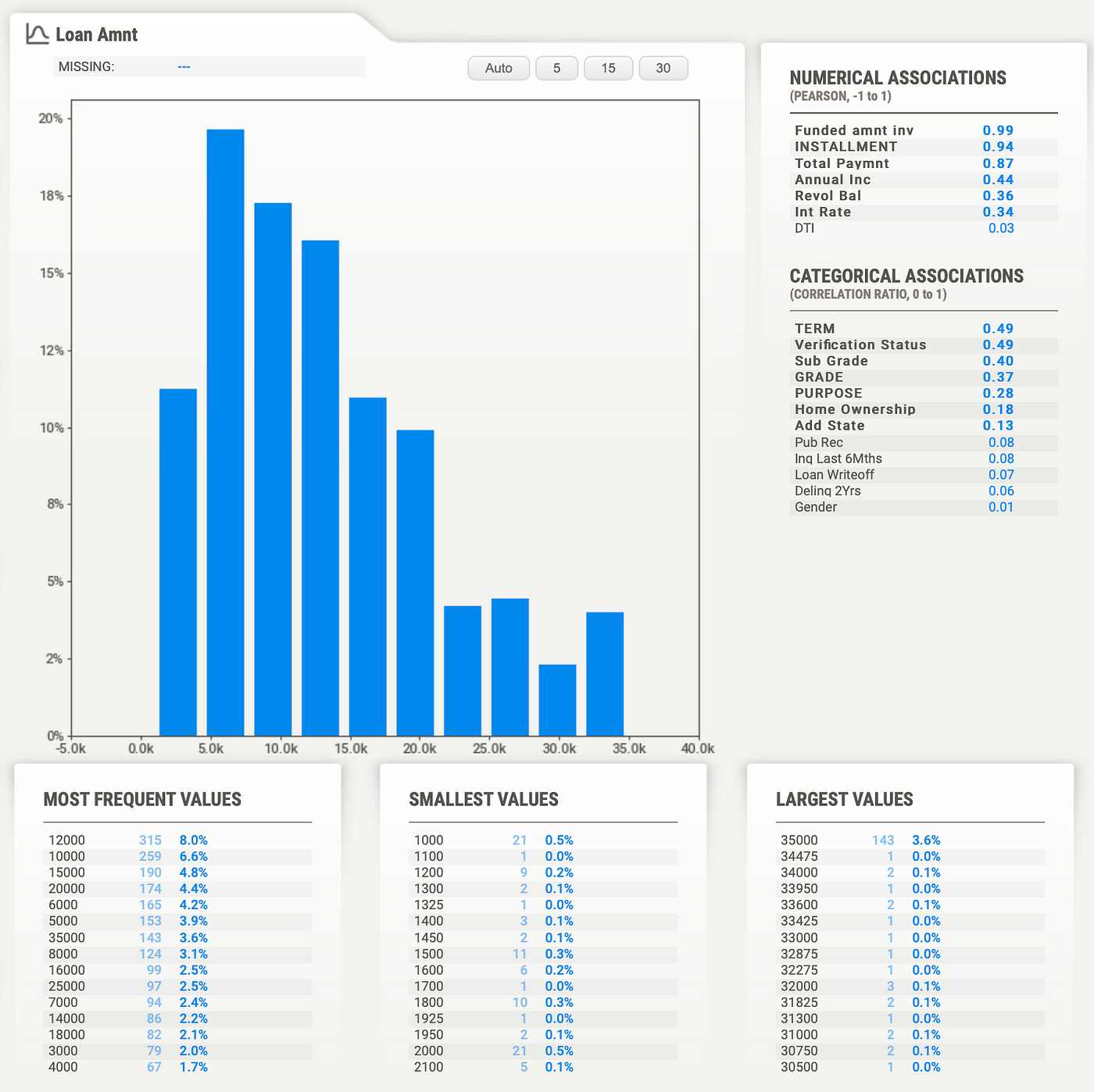
Determination
PyForest, Emot, Geemap, Dabl, and Sweetviz are libraries that deserve to be known because it turns complicated tasks into straightforward ones. If y'all use these libraries, y'all will salve your precious time with tasks that matter.
I recommend you endeavor them out and explore their functionalities that I didn't mention here. If you practice, let me know what you establish out about them. You can find the notebook I used to test them in my GitHub. Thank you for reading!
Yous might also similar…
iv Cool Python Libraries That Yous Should Know About
3 Awesome Python Libraries That You Should Know Nearly
three Low-Code Python that You Should Know About
Source: https://towardsdatascience.com/5-python-libraries-that-you-dont-know-but-you-should-fd6f810773a7
0 Response to "Python Libraries How to Know You Have"
Post a Comment